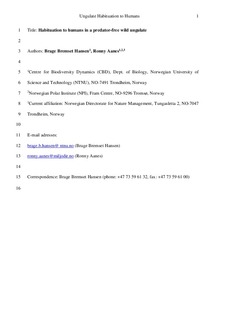| dc.contributor.author | Hansen, Brage Bremset | |
| dc.contributor.author | Aanes, Ronny | |
| dc.date.accessioned | 2017-10-09T12:56:43Z | |
| dc.date.available | 2017-10-09T12:56:43Z | |
| dc.date.created | 2014-09-18T21:14:31Z | |
| dc.date.issued | 2014 | |
| dc.identifier.citation | Polar Biology. 2014, 38 (2), 145-151. | nb_NO |
| dc.identifier.issn | 0722-4060 | |
| dc.identifier.uri | http://hdl.handle.net/11250/2459232 | |
| dc.description.abstract | Arctic caribou and reindeer face an increase in human activity, tourism and infrastructure, which impact may depend on the potential for habituation. Habituation to nonlethal human disturbance in wild animals depends on their risk perception and is therefore hard to separate from effects of predation and hunting pressure. Having evolved under strong isolation with negligible predation and only recent (and local) hunting, the high-Arctic wild Svalbard reindeer represent an adequate model system for studies of habituation to humans. Here, we test for habituation by repeatedly provoking 739 flight responses in 29 radio-collared females throughout two summers in a nonhunted population where human activity level decreases with the distance to a small settlement (Ny-Ålesund). Following provocation by an approaching human on foot, reindeer escape distance (ED) before resuming normal activity ranged from 5 to 500 m and was highly variable among individuals (individual median ED = 23–100 m). Controlling for the effects of individual, observer, terrain ruggedness (positive effect) and having a calf (positive effect), ED increased with distance to Ny-Ålesund [from 32 to 57 m (w/o calf) and 38 to 70 m (with calf) across ~1 to 24 km distance to Ny-Ålesund]. ED also decreased with approach number during the two-month-long summer [average 44–34 m (w/o calf) and 55–43 m (with calf)]. The present study has demonstrated that the naïve Svalbard reindeer habituates to human presence at small spatiotemporal scales through individual learning, suggesting that wild predator-free ungulates may adapt rapidly to increased human activity. | nb_NO |
| dc.language.iso | eng | nb_NO |
| dc.publisher | Springer Verlag | nb_NO |
| dc.title | Habituation to humans in a predator-free wild ungulate | nb_NO |
| dc.type | Journal article | nb_NO |
| dc.type | Peer reviewed | nb_NO |
| dc.description.version | acceptedVersion | nb_NO |
| dc.source.pagenumber | 145-151 | nb_NO |
| dc.source.volume | 38 | nb_NO |
| dc.source.journal | Polar Biology | nb_NO |
| dc.source.issue | 2 | nb_NO |
| dc.identifier.doi | 10.1007/s00300-014-1572-0 | |
| dc.identifier.cristin | 1155853 | |
| dc.relation.project | Norges forskningsråd: 223257 | nb_NO |
| dc.description.localcode | © Springer-Verlag Berlin Heidelberg 2014. The final publication isavailable at https://link.springer.com/article/10.1007%2Fs00300-014-1572-0. This is the authors' accepted and refereed manuscript to the article. | nb_NO |
| cristin.unitcode | 194,66,10,0 | |
| cristin.unitname | Institutt for biologi | |
| cristin.ispublished | true | |
| cristin.fulltext | postprint | |
| cristin.qualitycode | 1 | |
